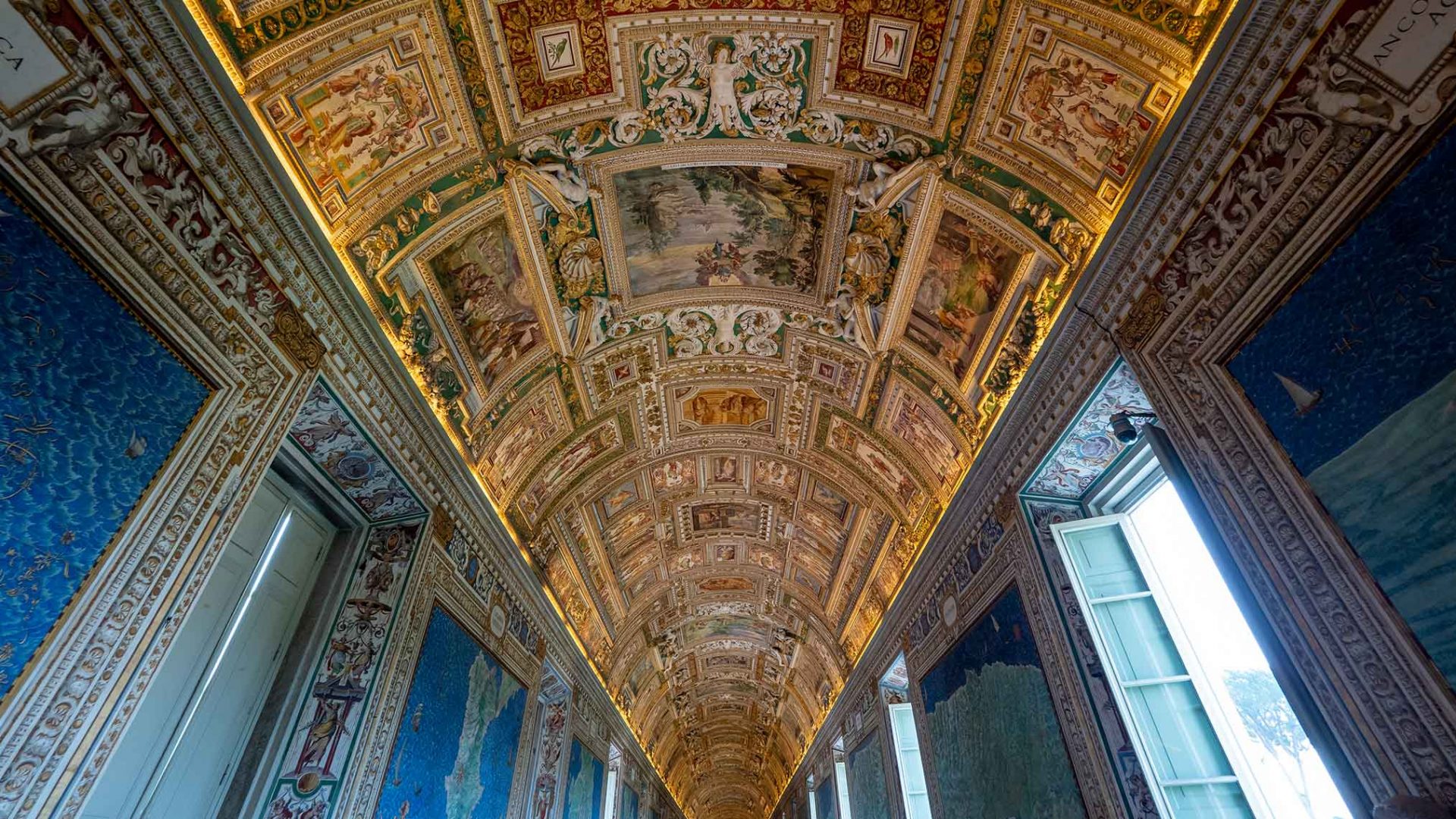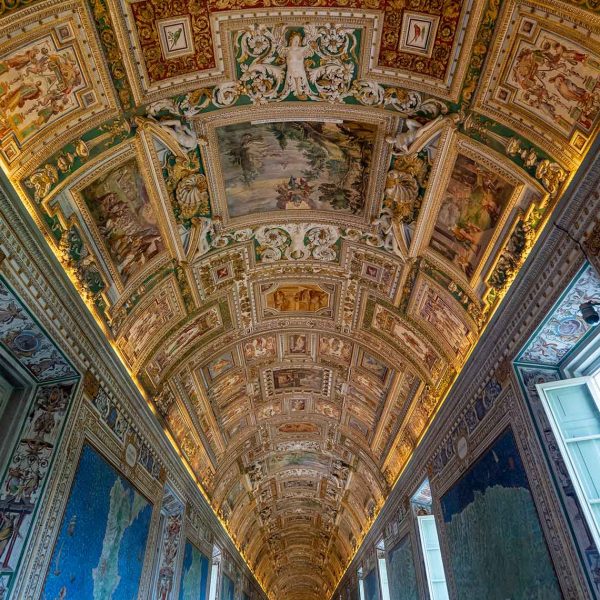
via del Monte 8, Bologna (Italy)
t +39 051 236760
info@palazzoboncompagni.it
Palazzo Boncompagni is social

The Quirinal Palace, Palazzo Boncompagni, the Gallery of Maps in the Vatican, the Marriage Mount: scattered between Bologna and Rome are numerous and significant works left to us by Gregory XIII. This episode maps them, illustrating their genesis and intent and introducing the architects and artists involved.
(Image, Map Gallery, Vatican Museums, Rome).

Like other great popes of the Renaissance, Gregory XIII Boncompagni also had a very important role as a promoter of the arts, starting in his native Bologna, where there is not only his large bronze statue in Piazza Maggiore, which he commissioned to Alessandro Minganti in 1575, but also the great Palazzo Boncompagni, where the future pontiff was born on January 1st 1501.
This palace took on its present form thanks to Cristoforo Boncompagni, the father of the future pontiff, who enlarged the first Boncompagni house, transforming it into a dwelling, he said, “worthy of a pope” and, without knowing it, Cristoforo Boncompagni was a prophet. A plaque on the first floor marked the end of the works in 1548. 1548 was the year Giacomo Boncompagni was born, the natural son of the future pope, to whom the palace of Bologna would be inherited.
From the glories of the late 16th century, this palace preserves, for example, the reception hall on the ground floor, admirably frescoed by Tibaldi with the stories of David and Samuel framed in a riot of grotesque decorations, animals, fantastic landscapes and characters from mythology, all in the most exquisite mannerist taste. The loggia is also noteworthy, supported by two elegant columns with a shaft decorated with foliage motifs.
No less famous is the small but spectacular helical staircase attributed to Vignola, which recently revealed a detail that had been lost. The walls were originally plastered with a mortar that imitated mother-of-pearl, so as to make the staircase appear inside it like a giant shell. On the noble floor, in the eighteenth century, a cycle of large canvases was prepared to recall the main events of the papacy of Gregory XIII.
Among these, the institution of the new calendar stands out, as well as the reception of the embassy of Japan and the institution of the Monte del Matrimonio.
The Monte del Matrimonio is still an active institution today. It was founded in Bologna in 1583 on the initiative of Marco Antonio Battilana, to help young people in crucial moments of their life. This institution was promoted by Gregory XIII and approved by Pope Sixtus V with the bull of May 9th 1586.
The main purpose of the Monte del Matrimonio was to provide a wedding dowry, but also to encourage young people to study and work in a religious profession. To this day the Monte del Matrimonio receives and administers the payments that the benefactors, called montists, make in favor of young people who will be able to collect the sums accrued upon the occurrence of some specific conditions provided for by the Statute, in particular marriage contracted according to the Catholic rite, degree or university level diploma, registration in a professional register, religious profession and perpetual vows, rank of officers and non-commissioned officers in effective permanent practice. And finally, role teaching in an elementary and nursery school.
With the election to the throne of Peter in 1572, Gregory XIII settled in Rome and never returned to his native Bologna, although he continued to keep alive, for example, the accent, as Montaigne testifies, which Pope Boncompagni said he had received as a blessing in pure Bolognese dialect.
In Rome, the pope promoted significant urban, building and artistic interventions. As a good jurist, he first promulgated the Constitution Quae Publice Utilia to try to improve the viability in Rome and stimulate construction. On the occasion of the Holy Year of 1575, the Pope specially enhanced the area of San Giovanni in Laterano with a door that he opened in the Aurelian Walls at a new access road to the city, the current Via Appia Nuova.
Then he had two new roads opened to connect the basilica of San Giovanni with the basilica of Santa Maria Maggiore and the door of San Sebastiano. In this way, the basilica of San Giovanni found itself at the center of a road system that radiated towards the main destinations of pilgrims. The ancient Ponte Milvio, known as the Ponte Rotto, was rebuilt by Matteo Bartolini and Giacomo della Porta was entrusted with the creation of four fountains in the squares of Rome, a fountain in Piazza Colonna, a fountain in the Piazza del Pantheon and two fountains in the end of the huge Piazza Navona.
In 1583, Gregory XIII began the construction of the Quirinal Palace. In this area there was already a villa, the villa of the Carafa, which however had been rented to Cardinal Ippolito II d’Este. This cardinal, together with his nephew, embellished the villa, especially the gardens, with fountains, water features and ancient sculptures. Pope Gregory was often a guest of Cardinal Ippolito d’Este in this villa and began to expand it at his own expense with the intention of making it his summer residence, since the area was considered the healthiest in the city due to its altitude. The project was entrusted to the architect Ottaviano Mascherino and the works were completed in 1585, but in that same year the death of the pope prevented Mascherino from starting a second project that involved the expansion of the building and this happened, above all, thanks to the pontificate of Paul V Borghese, when the Quirinal became the permanent residence of the popes until the end of the nineteenth century with Pope Pius IX.
Gregory XIII was also responsible for the beautiful restoration of the Lateran Baptistery and the construction of the chapel of the Blessed Sacrament in San Giovanni in Laterano itself. We owe to him the church of Santa Maria ai Monti, a masterpiece by Giacomo della Porta, and the construction of the Gregorian Chapel in the Basilica of San Pietro. The artistic interventions promoted by Gregory XIII in the Vatican were also very remarkable: the frescoes in the Sala Regia entrusted to Giorgio Vasari and Federico Zuccari, those on the vault of the Sala di Costantino painted by Tommaso Laureti, and then the construction of the Tower of the Four Winds, frescoed by Nicolò Circignani and the brothers Matteo and Paolo Bril.
But the most spectacular cycle, promoted by Gregory XIII in the Vatican, was undoubtedly represented by the Galleria delle Carte Geografiche. Built by the architect Mascherino as a covered passage for the pontiff, this gallery is 120 meters long and 6 meters wide. It is famous for the exceptional cartographic representation of the regions of Italy which is affixed to the walls. This cycle constitutes a very precious testimony of the geographical knowledge and the state of the places of Italy in the late 1500s and is a remarkable document, also because the geographical and spiritual unity of the whole of Italy is affirmed for the first time.
It was Pope Gregory who ordered the construction and the frescoes of the gallery. The decoration work was directed by the Dominican mathematician and geographer Ignazio Danti, a great friend of the pope. Going through the tunnel had to be, according to Dante’s intentions, like traveling on the ridge of the Apennines and looking out over the Adriatic coast to the east and the Tyrrhenian coast to the west. A journey marked by 40 maps that took the traveler through all the regions of Italy, in the main cities, as well as in the main ports of the sixteenth century, which at the time were Civitavecchia, Genoa, Ancona and Venice.
The artists who worked on the cycle were Gerolamo Muziano, Cesare Nebbia, the Flemish brothers Matteo and Paolo Bril, Giovanni Antonio Varesino from Varese and Antonio Danti, who decorated and frescoed the gallery between 1580 and 1585, always following the instructions of Ignazio Danti. The vault was also painted. The decoration was entrusted to Antonio Tempesta and his pupils, who depicted miraculous episodes placed in correspondence with the Italian region from which they had come.
In this way the whole of Italy was considered as the land in which divine Providence, in all its parts, had spread its grace.
Even though he never returned to Bologna, Gregory XIII always remained very attached to his hometown, to the point that he had a banquet hall built in the Vatican calling it Sala Bologna.
Here a team of painters led by Lorenzo Sabatini decorated the walls with geographic and cosmological frescoes, all aimed at celebrating the Pope’s birthplace. In the room, which today is not accessible to the public, you can admire large maps, among which is the monumental View of the city of Bologna which occupies the entire south wall and which is considered to be the largest portrait of the city ever frescoed during the Renaissance.
If you look closely, you can also recognize Palazzo Boncompagni. The pope wanted it to be highlighted and the painters obeyed, finding a singular solution to make identification easy: they painted the roof of the palace in gold, a privilege granted in this map only to churches, bell towers and religious buildings.
Gregorius: Ugo Boncompagni, A Great Bolognese Pope.
A podcast in three written episodes narrated by Marco Carminati and directed by Ottavia Casagrande